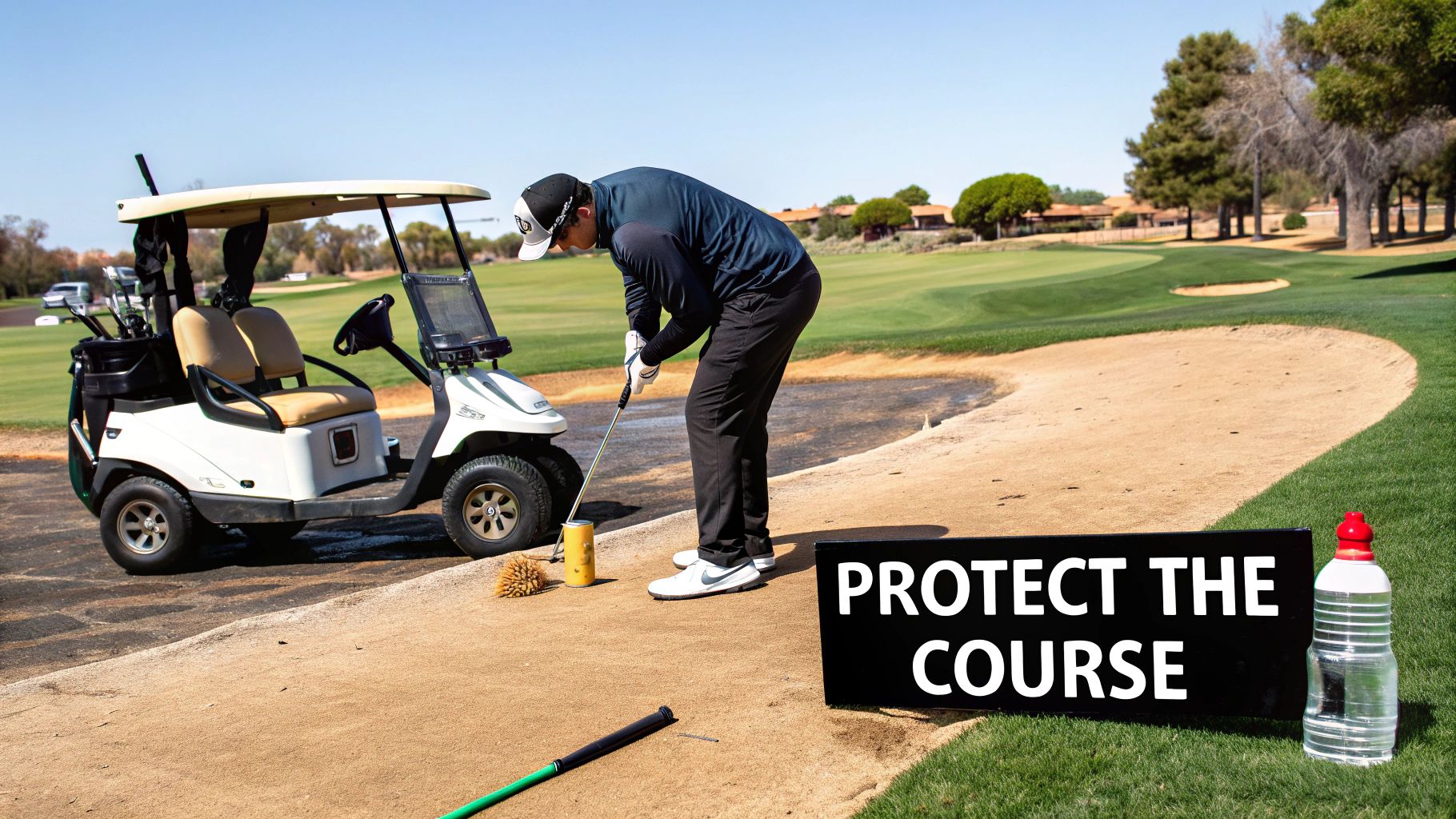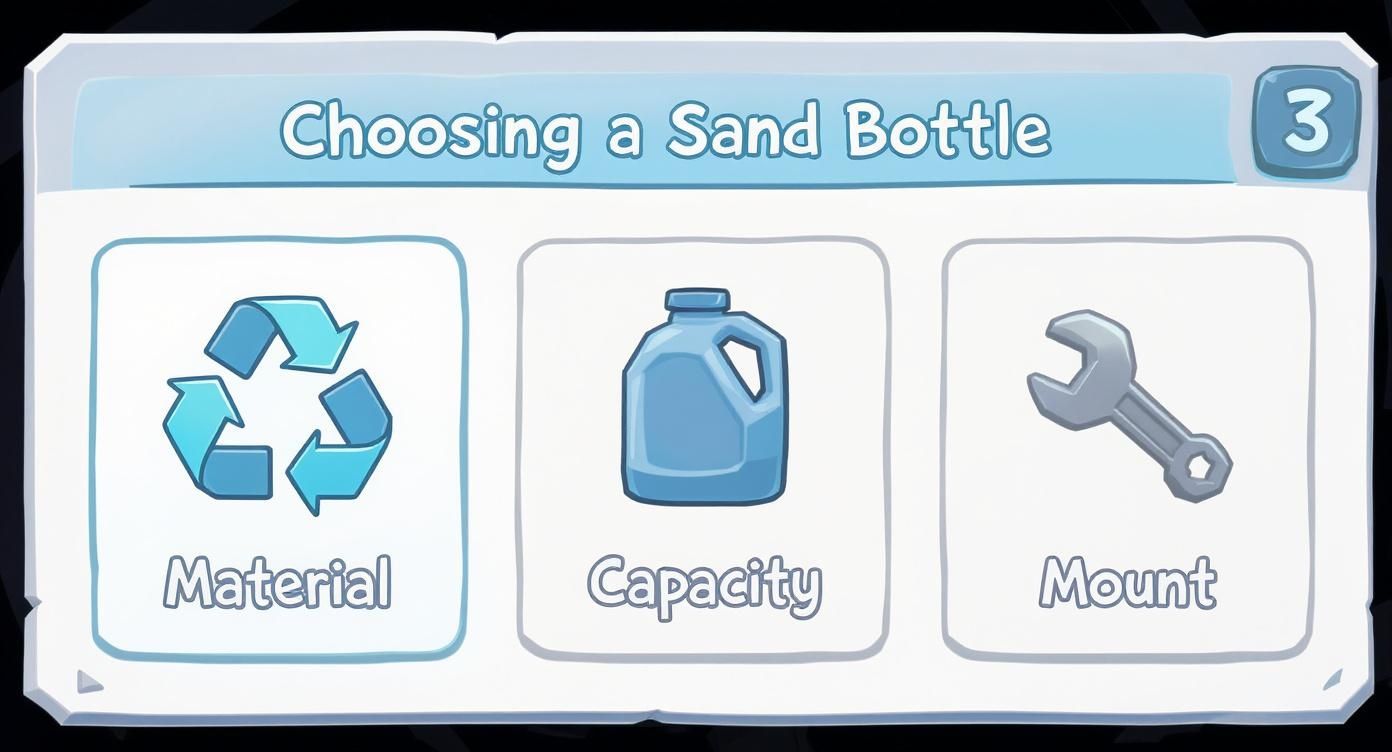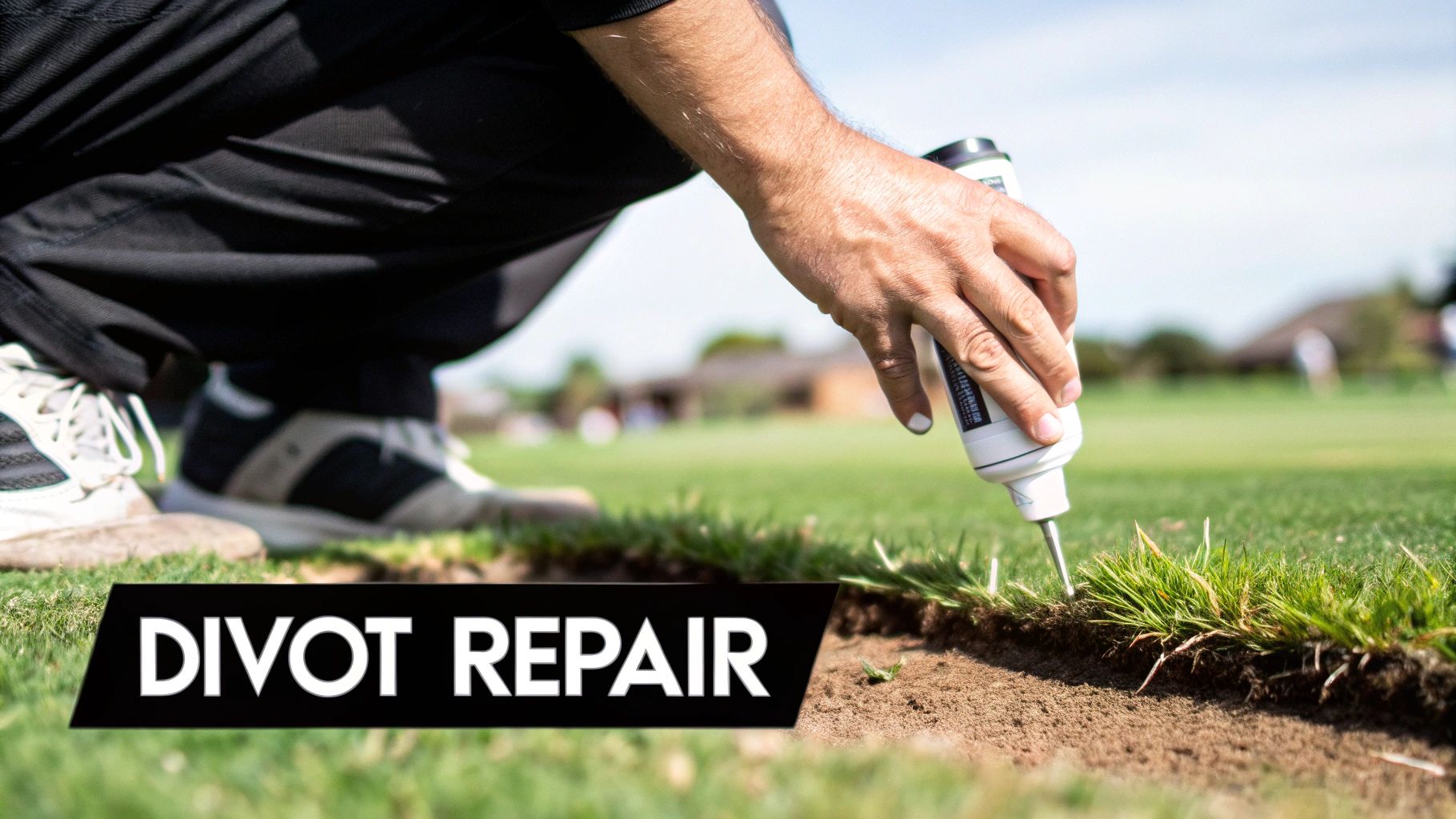Walk onto any well-kept golf course, and you'll see them: golf cart sand bottles. These simple containers are more than just an accessory; they're a crucial tool for keeping the turf healthy. Every time a golfer takes a swing and creates a divot, a quick fill from a sand bottle helps the grass heal. It's a small act, but it’s a cornerstone of good golf etiquette and makes a huge difference in preserving the fairway.
Why Sand Bottles Are Essential for Every Golfer
Ever hit a perfect approach shot, only to find your ball nestled in an ugly, unrepaired divot? It’s one of the most frustrating moments in golf. This exact scenario is why having a sand bottle on your cart is so important. They’re not just for show—they’re fundamental to course preservation.
When a sand bottle is right there on your cart, taking care of the course becomes a natural part of your routine, not some chore you have to think about. It’s a simple tool that plays a massive role in maintaining the turf and upholding the unwritten rules of the game.

Promoting Turf Health and Playability
Each divot you repair does more than just fill a hole. It protects the grass's sensitive root system from getting scorched by the sun, which speeds up its recovery. A quick fill also stops weeds from creeping in and ensures a smooth, fair playing surface for every golfer who follows you. It's a collective effort that keeps a course in prime condition.
The impact of this one small action is bigger than you might think. It contributes to:
- Faster Turf Recovery: The special sand-and-seed mix gives the grass the perfect environment to regrow quickly and strong.
- Improved Playing Conditions: A fairway free of divots means more consistent ball lies and a much better round for everyone.
- Enhanced Course Aesthetics: Let’s be honest, a well-maintained course just looks better. It’s a sign of a community that respects the game.
Taking just a few seconds to fix your divot is a direct investment in the quality of the course for you and every other player. It's a tiny bit of effort that pays off in a big way.
A Growing Part of the Golf Economy
This commitment to course care has even carved out its own niche in the market. The global golf divot sand bottle market has ballooned to a USD 145.8 million valuation and is expected to keep growing. It’s amazing to see how a simple act of etiquette has become its own industry.
At the end of the day, carrying and using a sand bottle is about more than just following the rules. It's about respecting the course and making the game better for everyone. This small habit also helps keep up a good pace of play, which is another huge part of golf etiquette. For more on that, check out our guide on golf pace of play guidelines.
How to Choose the Right Sand Bottle for Your Cart
Picking the right sand bottle for your golf cart isn't as simple as grabbing the first one you see off the shelf. The best choice really comes down to your specific cart, how often you’re out on the course, and even the types of tracks you play. It’s all about finding a setup that makes course care a natural part of your game, not a clumsy chore.
First, think about how you play. If you and a partner are often on a busy course, a dual-bottle setup—one for each side of the cart—is a game-changer. This way, both players can quickly repair divots without having to awkwardly walk around the cart, which helps keep the pace of play moving right along. For a solo golfer, though, a single large-capacity bottle is usually more than enough.
Material and Design Matter
The bottle's construction is a bigger deal than you might think. Most are made from tough plastics built to handle sun, rain, and the occasional bump against a tree. When you're shopping, look for materials like high-density polyethylene (HDPE) or something similarly rugged. You’ll also want to pay attention to the handle—an ergonomic grip makes it much easier to hold and aim, especially when you're hopping off the cart for a quick fix.
The spout design is another small detail that makes a huge difference in accuracy. Some bottles have a simple, wide-open top, but others feature a focused nozzle or a curved "gooseneck" shape. That gooseneck style gives you much better control over the sand flow, helping you fill the divot perfectly without scattering sand all over the healthy turf. When you're picking a bottle, it helps to know what it's made of; you can learn more about what BPA Free plastic means and why it's important for different containers.
Pro Tip: Keep an eye out for bottles with a slightly wider mouth. This simple feature makes refilling at course stations so much faster and cleaner. Trust me, it saves you from frustrating spills and wasted time.
To help you decide, here’s a quick breakdown of what to look for in a sand bottle.
Sand Bottle Feature Comparison
| Feature | Material Type | Capacity | Best For |
|---|---|---|---|
| Ergonomic Handle | HDPE Plastic | 1.25 Quarts | Players who want a comfortable, secure grip for quick divot repairs. |
| Gooseneck Spout | UV-Resistant Plastic | 1.5 Quarts | Golfers who prioritize precise sand placement and minimal spillage. |
| Universal Mount | Durable Polycarbonate | 1 Quart | Cart owners needing a flexible option that fits various models. |
| Dual-Bottle Kit | HDPE Plastic | 2.5 Quarts Total | Foursomes or partners looking for maximum convenience and capacity. |
Ultimately, comparing these features will point you toward the bottle that best fits your on-course habits.
Finding the Perfect Mount
A great bottle is pretty useless if it’s rattling around in the back or, worse, falls off mid-round. A secure mounting system is what keeps your bottle stable and right where you need it through every bump and turn on the cart path. You'll generally find two types of mounts out there: universal and cart-specific.
- Universal Brackets: These are designed to fit a wide range of cart frames, usually by clamping onto a front strut or rear fender. They’re flexible but sometimes need a little tweaking to get a perfectly snug fit.
- Cart-Specific Models: These are engineered to match popular models from brands like Club Car, EZGO, and Yamaha. They often use pre-existing holes in the frame, giving you a clean, factory-finish look without any guesswork.
Before you pull the trigger, it’s always smart to double-check which style works best for your ride. You can learn more about which accessories fit your specific model by checking out this list of https://caddiewheel.com/pages/compatible-carts. Taking a moment to match the mount to your cart is the key to a secure, rattle-free installation that will last for seasons to come.
A Practical Guide to Installing Your Sand Bottle
Getting your new sand bottle installed is a quick project you can knock out in a few minutes with some basic tools. Most universal kits are designed to be pretty straightforward, but the real key is picking the right spot to mount it for practical, on-course use.
You’ve really got two main options: the front strut or a rear fender.
Mounting the bottle on a front strut keeps it within easy reach for both the driver and the passenger. It's the perfect spot for quick access without having to get out of your seat. On the other hand, attaching it to a rear fender puts it right next to your clubs, which feels natural when you’re grabbing a club and getting ready for your next shot. Honestly, it just comes down to personal preference and the specific layout of your cart.
This visual guide breaks down the key factors to consider when selecting your golf cart sand bottle.

As the infographic shows, the material, capacity, and mount type are the big three when it comes to making a practical choice that you’ll actually use.
Ensuring a Secure Fit
No matter where you decide to mount it, a secure fit is non-negotiable. There's nothing worse than a rattling, loose bottle that sounds like it's about to fall off over every bump.
Many kits come with rubber gaskets or spacers—don't just toss those aside. They’re crucial for absorbing vibrations and creating a much tighter connection between the mounting bracket and your cart's frame.
If you find that the pre-drilled holes on a universal bracket don't line up perfectly with your cart's frame, don't try to force it. A much better solution is to drill new holes in the bracket itself (never the cart frame!) to get a perfect alignment. This tiny adjustment ensures the bolts aren't under stress and gives you a far more stable installation for the long haul.
A secure installation prevents annoying rattles and ensures your golf cart sand bottles are always ready for action. Take an extra minute to tighten all hardware and use rubber gaskets—it makes a world of difference on the course.
The growing demand for user-friendly accessories like these really reflects the broader expansion of the golf industry. The global golf cart market, valued at USD 2.06 billion, is projected to hit USD 3.21 billion by 2033, thanks in large part to major investments in course infrastructure. You can explore more about this market growth and its impact on the sport.
Mastering the Art of Divot Repair
Using those sand bottles on your golf cart is about more than just filling a hole. There's a real technique to it, one that helps the turf heal quickly and properly. It all starts with how you fill the bottle.
Always grab a funnel. It prevents you from spilling the valuable seed mix, which isn't just plain sand. Courses use a carefully balanced blend of sand, soil, and grass seed specifically chosen for their fairways. The sand gives it structure, the soil provides nutrients, and the seed ensures the new grass matches. Just scooping up any old sand from a bunker simply won't cut it.

The Correct Repair Method
Once your bottle is filled and you're out on the course, a proper fix is pretty straightforward if you follow a few key steps.
- First, prep the divot. Use your foot to gently press the edges of the divot back inward. This helps the torn turf reconnect with the soil below.
- Next, fill it in. Pour the sand and seed mix from your bottle until the depression is level with the surrounding grass. You're not trying to build a mound here.
- Finally, tamp it down. A light press with your foot or the back of a club is all you need to settle the mix and create a smooth, even surface.
This small act of course care is a global practice, vital for maintaining courses everywhere from your local club to world-famous venues.
A common mistake I see all the time is overfilling the divot. Piling on too much sand creates a mound that can damage expensive mower blades and, ironically, creates an uneven playing surface. Keep it level!
While this technique is perfect for fairway divots, understanding general lawn care can be a huge help. Knowing how to effectively fix bare spots in your lawn uses similar principles and helps you keep things looking pristine, even when you're off the course.
A Little Upkeep Goes a Long Way
To keep your golf cart sand bottles in top shape, a little proactive care makes a huge difference. These simple habits will help you avoid the most common headaches—like clogs and cracks—and keep you focused on your game, not your gear.
The biggest culprit for sand bottle issues? Moisture. When your sand and seed mix gets damp from rain or even just heavy morning dew, it clumps up and plugs the spout. It's an easy fix, though. After a wet round, just take a minute to empty the bottle, give it a good rinse with water, and let it air dry completely before you fill it back up. This simple step prevents mold and guarantees a smooth pour every time.
Quick Checks for Peak Performance
Beyond just cleaning, a few quick inspections will keep your sand bottle setup secure and ready for action. The constant vibrations from driving over cart paths and fairways can slowly but surely loosen hardware.
Here's what to look out for:
- Tighten the Bracket: About once a month, give the mounting bracket a quick wiggle. Make sure all the nuts and bolts are snug so it doesn't rattle itself loose.
- Inspect for Damage: Take a peek at the plastic bottle itself every so often. You're looking for any small cracks or signs of wear. UV rays from the sun can make plastic brittle over time.
- Store It Smart: If you can, park your cart under a cover or in a garage. Keeping it out of direct, prolonged sunlight is the single best thing you can do to prevent the plastic from getting brittle and breaking down.
A well-maintained sand bottle is a reliable one. These quick checks are part of a broader upkeep routine that protects your investment. To learn more, explore these essential golf cart maintenance tips.
Got Questions About Your Sand Bottles? We've Got Answers.
So, you've got the gear installed, but you might still be wondering about the finer points of using and managing your golf cart sand bottles. Nailing these details is what separates a quick fix from a truly seamless repair, and it clears up some of the most common mix-ups I see out on the course.
Let's start with the big one: the sand itself. It's not just about grabbing a scoop from the nearest bunker. Courses provide a special mix for a reason, and using it makes all the difference.
What’s the Right Sand Mix to Use?
The ideal mixture—which you’ll almost always find at filling stations near the clubhouse or first tee—is a carefully crafted blend of sand, nutrient-rich soil, and grass seed. Think of it as a first-aid kit for the turf, specifically formulated to match the course's unique grass.
- Sand gives the divot structure and helps with drainage.
- Soil delivers the key nutrients grass roots need to recover and thrive.
- Grass seed kickstarts new growth, ensuring the scar heals perfectly.
Using plain bunker sand is a common mistake, but it just doesn't work. It’s missing the nutrients and seed required for regrowth. For the best results, always stick with the mix the course provides.
How Many Sand Bottles Should Be on a Cart?
For a standard two-person golf cart, the magic number is two—one mounted on each side. This isn't just for looks; it's a huge advantage for convenience and keeping the pace of play moving.
When there's a bottle within arm's reach for both the driver and the passenger, either person can instantly repair a divot. No more awkward shuffling around the cart or waiting for your partner. It makes divot repair a natural, quick habit. If you happen to be cruising in a single-rider cart, one bottle is all you need.
The goal is to make divot repair an effortless, automatic part of your routine. Having a bottle readily accessible to every player on the cart is the key to making that happen.
Can I Put a Sand Bottle on My Personal Cart?
Absolutely. Most modern sand bottle kits you can buy today come with universal mounting brackets. These are designed to be pretty adaptable, fitting the frames of nearly any golf cart model, whether it’s a fleet cart at your club or your personal ride you use around the neighborhood.
The most important thing is to make sure the bottle is mounted securely. You want it somewhere it won’t get in your way, interfere with controls, or block any required safety features—especially if your cart is street-legal. A good spot is typically on the frame post next to the seat.


Share:
Your Guide to Electric Caddie Golf Carts
Club Car vs EZ GO An Unbiased Comparison Guide